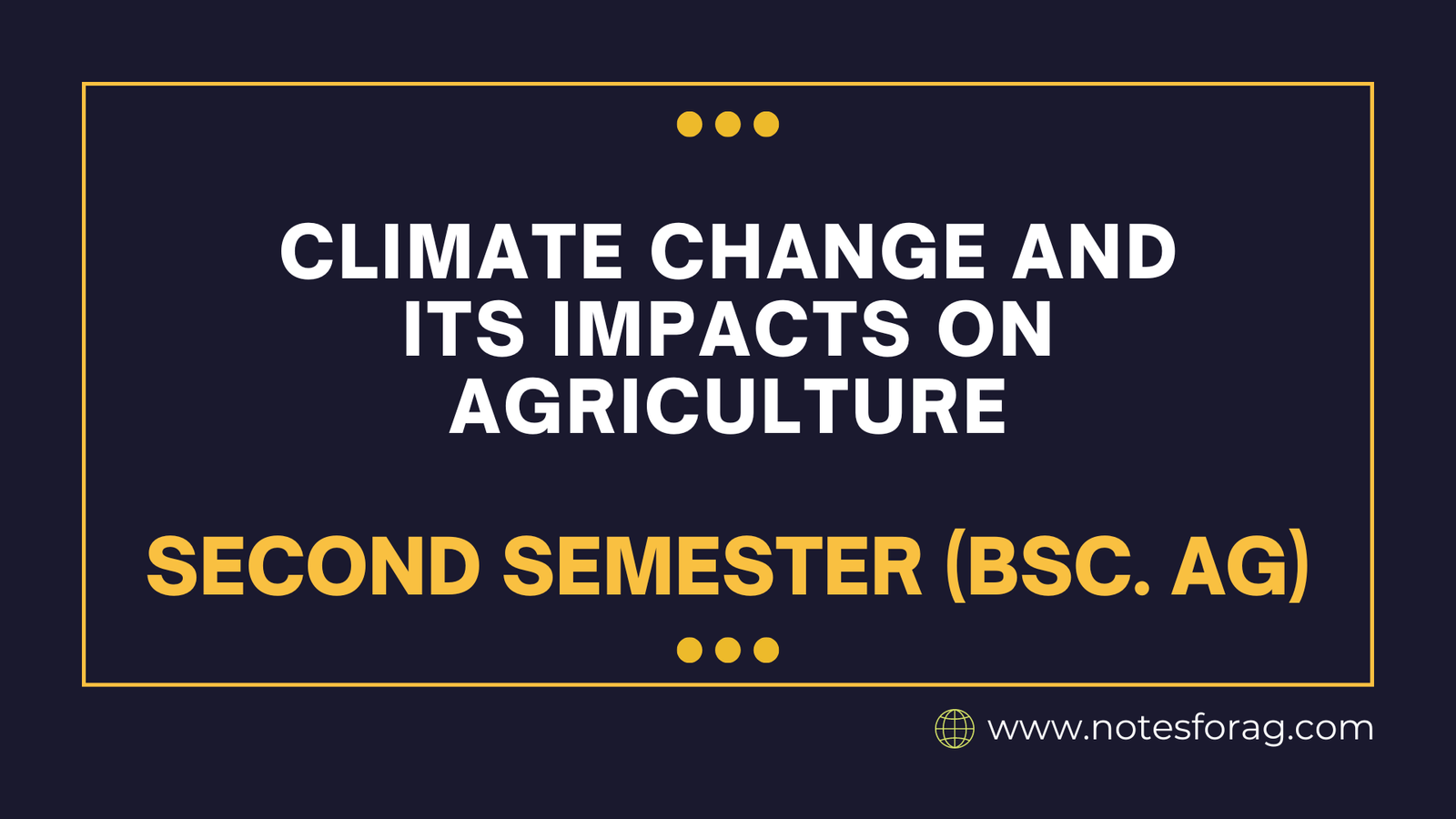Climate change has a huge impact on agriculture because it alters weather patterns, increases the frequency of extreme weather events, and shifts climate zones. Rising temperatures, variable rainfall, and lengthy droughts all have an impact on food production and water availability, while increased flood and storm activity can devastate agriculture and infrastructure. These changes threaten food security, alter farming methods, and need adaptive strategies to maintain agricultural output and resilience in the face of changing climate circumstances.
Table of Contents
Introduction to Climate Change

Climate change refers to large, long-term changes in global weather patterns caused primarily by human activity. The science of climate change is based on the greenhouse effect, a natural process that heats the Earth’s surface. When the Sun’s energy reaches Earth, it is either reflected back into space or absorbed and re-radiated as heat. Greenhouse gases (GHGs) such as carbon dioxide (CO2) and methane (CH4) capture some of this heat, preventing it from escaping into space and warming the earth.
Human activities, particularly since the Industrial Revolution, have significantly increased the concentration of greenhouse gases in the atmosphere. Burning fossil fuels like coal, oil, and natural gas for energy and transportation emits large volumes of CO2. Additionally, deforestation limits the quantity of plants capable of absorbing CO2, worsening the problem. Other human activities that contribute to climate change include industrial processes, agricultural practices, and waste management, all of which emit greenhouse gases such as methane and nitrous oxide.
Climate Change Impacts on Agriculture
Climate change has a significant and far-reaching impact on crop output, chiefly through changes in temperature and precipitation patterns. These changes have a substantial impact on growing seasons and crop production. For example, higher temperatures may cause crops to mature earlier, reducing the amount of time available for photosynthesis and potentially lowering yields.
1. Changed Weather Patterns:

Climate change alters weather patterns, including precipitation and temperature regimes. Growing seasons in different regions may vary, affecting crop rotations and harvest periods. For example, earlier springs and prolonged warm spells can alter planting and harvesting schedules, affecting crop yields and quality.
2. Increased Frequency of Extreme Weather Events:
Droughts, floods, and storms are becoming more frequent and intense as a result of climate change. These occurrences can result in quick and severe damage to crops, livestock, and agricultural infrastructure. Droughts cause water shortages and low soil moisture, whereas floods can sweep away topsoil, kill crops, and erode cropland.
3. Changes in Climate Zones:

As global temperatures rise, climatic zones fluctuate, altering the suitability of places for various crops. Areas that were formerly favorable for certain crops may become unsuitable, forcing adjustments in crop choices and farming practices. This shift may also result in the spread of pests and illnesses to new areas, further affecting agricultural productivity.
4. Water scarcity and irrigation challenges:
Changes in precipitation patterns and rising evaporation rates all lead to water scarcity, which affects irrigation techniques. Reduced water supply has an impact on crop growth, particularly in irrigation-dependent countries. Efficient water management and the use of drought-resistant crop cultivars are crucial to sustaining agricultural productivity.
5. Soil degradation:
Climate change exacerbates soil degradation by causing more erosion, salinization, and nutrient loss. Extreme weather events, such as excessive rainfall and flooding, can cause soil erosion, whereas protracted dry periods can deplete soil organic matter and fertility. Maintaining soil health through conservation methods is critical for long-term agricultural sustainability.
6. The impact on livestock:
Rising temperatures and shifting weather patterns have an impact on livestock health, production, and wellbeing. Heat stress can diminish animal output, disrupt reproductive, and make them more susceptible to disease. Changes in feed availability and quality caused by changing crop production have an impact on cattle nutrition and growth.
7. Food Security:
The cumulative consequences of climate change on crop yields, water resources, and soil health pose serious threats to food security. Reduced agricultural production can result in higher food costs, increased competition for resources, and greater vulnerability of food systems. Food security necessitates adaptive strategies such as diversifying crop output, improving storage facilities, and building resilient supply lines.
Adaptive Strategies
To limit the effects of climate change on agriculture, farmers and policymakers must implement adaptive methods. This includes:
1. Climate-resistant Crop Varieties: Crop development and planting for drought, heat, and insect resistance.
2. Sustainable farming practices: Increasing resilience through conservation agriculture, agroforestry, and integrated pest management.
3. Efficient Water Management: Using modern irrigation methods, rainwater gathering, and soil moisture conservation.
4. Technological innovations: Using technology for precision agriculture, weather forecasting, and early warning systems.
5. Policy Support: Developing policies that encourage sustainable agriculture, provide financial assistance to farmers, and invest in R&D.
Climate change poses huge difficulties to agriculture, jeopardizing food security and lives worldwide. Understanding and resolving the multiple implications via adaptive methods, technology advances, and sustainable practices is critical for developing resilient agricultural systems that can resist climatic change. By encouraging collaboration among farmers, academics, politicians, and communities, we can improve agricultural resilience and assure food security in a changing environment.
Frequently Asked Question(FAQ)
How does climate change affect agriculture?
Climate change has an impact on agriculture by changing weather patterns, increasing the frequency of extreme weather events, shifting climatic zones, generating water scarcity, and deteriorating soil quality. These changes affect crop production, livestock output, and overall food security.
What are the main climate-related challenges faced by farmers?
Farmers face numerous challenges, including irregular rainfall, extended droughts, violent storms, floods, heat stress on crops and livestock, and the introduction of pests and diseases to new places. These issues can result in lower production and increased susceptibility.
Related Articles

